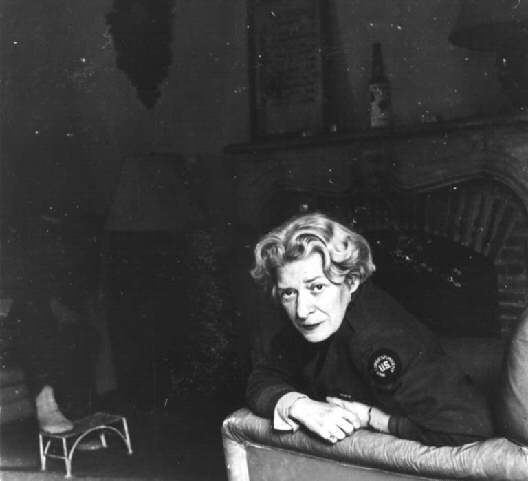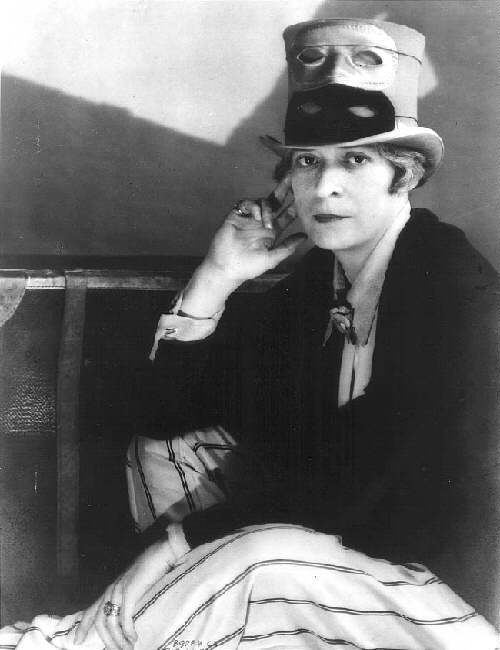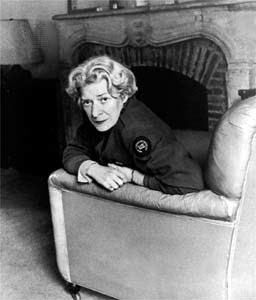Nationality American Name Janet Flanner | Role Writer | |
 | ||
Occupation Writer, journalist,war correspondent Known for Foreign correspondent in Paris, 1925–1975 Died November 7, 1978, New York City, New York, United States Spouse William "Lane" Rehm (m. 1918–1924) Movies Norman Mailer: The American Books Darlinghissima, Janet Flanner's world, Men and monuments, Paris was Yesterday - 1925‑1939, Paris Journal | ||
Hide/Seek: Portraits of Djuna Barnes and Janet Flanner
Janet Flanner (March 13, 1892 – November 7, 1978) was an American writer and journalist who served as the Paris correspondent of The New Yorker magazine from 1925 until she retired in 1975. She wrote under the pen name "Genêt". She also published a single novel, The Cubical City, set in New York City.
Contents
- HideSeek Portraits of Djuna Barnes and Janet Flanner
- The writer in america janet flanner
- Early life
- Marriage and personal life
- Expatriate years in Paris
- Years as a war correspondent
- Awards and recognitions
- Later life and death
- References

The writer in america janet flanner
Early life
Janet Flanner was born in Indianapolis, Indiana to Frank and Mary Flanner. She had two sisters, Marie and Hildegarde Flanner. Her father co-owned a mortuary and ran the first crematorium in the state of Indiana. After a period spent traveling abroad with her family and studies at Tudor Hall School for Girls (now Park Tudor School), she enrolled in the University of Chicago in 1912, leaving the university in 1914. Two years later, she returned to her native city to take up a post as the first cinema critic on the local paper, the Indianapolis Star.
Marriage and personal life

In 1918 she married William "Lane" Rehm, a friend that she had met while at the University of Chicago. He was then an artist in New York City, and she later admitted that she married him to get out of Indianapolis. The marriage lasted for only a few years and they divorced amicably in 1926. Rehm was supportive of Flanner's career until his death.

In 1918, the same year she married her husband, she met Solita Solano in Greenwich Village, and the two became lifelong lovers, although both became involved with other lovers throughout their relationship. Solano was drama editor for the New York Tribune, and also wrote for National Geographic. The two women are portrayed as "Nip" and "Tuck" in the 1928 novel Ladies Almanack, by Djuna Barnes, a friend of Flanner's. While in New York, Flanner moved in the circle of the Algonquin Round Table, but was not a member. She also met the couple, Jane Grant and Harold Ross, through painter Neysa McMein. It was based on this connection that Harold Ross offered Flanner the position of French Correspondent to the New Yorker.
After these early years spent in Pennsylvania and New York in her mid twenties, Flanner left the United States for Paris.
Expatriate years in Paris
In September 1925 Flanner published her first "Letter from Paris" in The New Yorker, which had been launched the previous February, and with which she would be professionally linked for the next five decades. Her columns covered a wide range of topics, including artists, performances, and crime, including a lengthy feature on murderesses Christine and Léa Papin. She also published several installments about the Stavisky Affair. Flanner was also known for her obituaries—examples include those of Isadora Duncan and Edith Wharton. Flanner had first come to the attention of editor Harold Ross through his first wife, Jane Grant, who was a friend of Flanner's from the Lucy Stone League, an organization that fought for women to preserve their maiden names after marriage, in the manner of Lucy Stone. Flanner joined the group in 1921. Ross famously thought Flanner's pen name "Genêt" was French for "Janet".
Flanner was a prominent member of the American expatriate community which included Ernest Hemingway, F. Scott Fitzgerald, John Dos Passos, e. e. cummings, Hart Crane, Djuna Barnes, Ezra Pound, and Gertrude Stein – the world of the Lost Generation and Les Deux Magots. While in Paris she became very close friends with Gertrude Stein and her lover, Alice B. Toklas. In 1932 she fell in love with Noel Haskins Murphy, a singer from a village just outside Paris, and had a short-lived romance. This did not affect her relationship with Solano.
She played a crucial role in introducing her contemporaries to new artists in Paris, including Pablo Picasso, Georges Braque, Henri Matisse, André Gide, Jean Cocteau, and the Ballets Russes, as well as crime passionel and vernissage, the triumphant crossing of the Atlantic Ocean by Charles Lindbergh and the depravities of the Stavisky Affair.
Her prose style has since come to epitomise the "New Yorker style" – its influence can be seen decades later in the prose of Bruce Chatwin. An example: "The late Jean De Koven was an average American tourist in Paris but for two exceptions: she never set foot in the Opéra, and she was murdered."
She was a frequent visitor to Los Angeles because her mother, Mary, lived at 530 E. Marigold St. in Altadena with her sister, poet Hildegarde Flanner, and brother-in-law, Frederick Monhoff.
Years as a war correspondent
Flanner lived in New York City during World War II with Natalia Danesi Murray and her son William B. Murray, still writing for The New Yorker. She returned to Paris in 1944.
Her New Yorker work during World War II included not only her famous "Letter from Paris" columns, but also included a seminal 3-part series profiling Hitler (1936), and coverage of the Nuremberg trials (1945). Additionally, she contributed a series of little-known weekly radio broadcasts for the NBC Blue Network during the months following the liberation of Paris in late August 1944. There is an iconic photograph of her sitting with Ernest Hemingway in the café Les Deux Magots taken shortly after the liberation.
Flanner authored one novel, The Cubical City, which achieved little success.
In 1948 she was made a knight of Legion d'Honneur. She covered the Suez crisis, the Soviet invasion of Hungary, and the strife in Algeria which led to the rise of Charles de Gaulle. She was a leading member of the influential coterie of mostly lesbian women that included Natalie Clifford Barney and Djuna Barnes. Flanner lived in Paris with Solano, who put away her own literary aspirations to be Flanner's personal secretary. Even though the relationship was not monogamous, they lived together for over 50 years.
Awards and recognitions
In 1958 Flanner was awarded an honorary doctorate by Smith College.
In 1966 she won the U.S. National Book Award in the Arts and Letters category for her For Paris Journal, 1944–1965. Extracts of her Paris Journal were turned into a piece for chorus and orchestra by composer Ned Rorem.
In 1971, she was the third guest during the infamous scuffle between Gore Vidal and Norman Mailer on the Dick Cavett Show, getting in between the two after a drunken Mailer started insulting his fellow guests and their host.
Later life and death
In 1975, Flanner returned to New York City permanently to be cared for by Natalia Danesi Murray. She died on November 7, 1978, of undetermined causes. Flanner was cremated, and her ashes were scattered along with Murray's over Cherry Grove in Fire Island where the two had met in 1940, according to Murray's son in his book Janet, My Mother, and Me.
